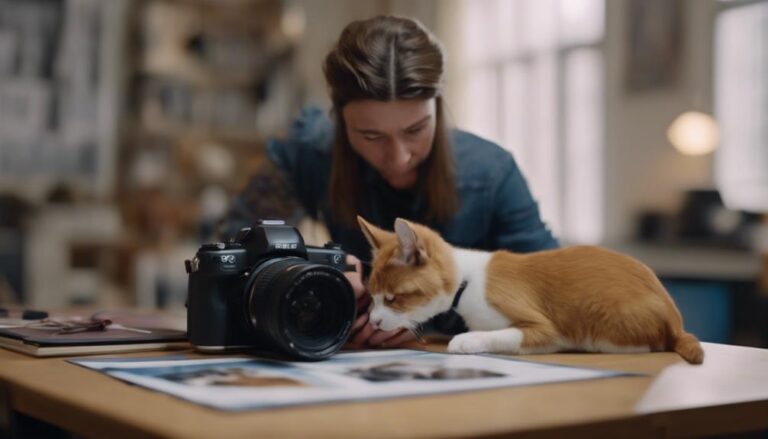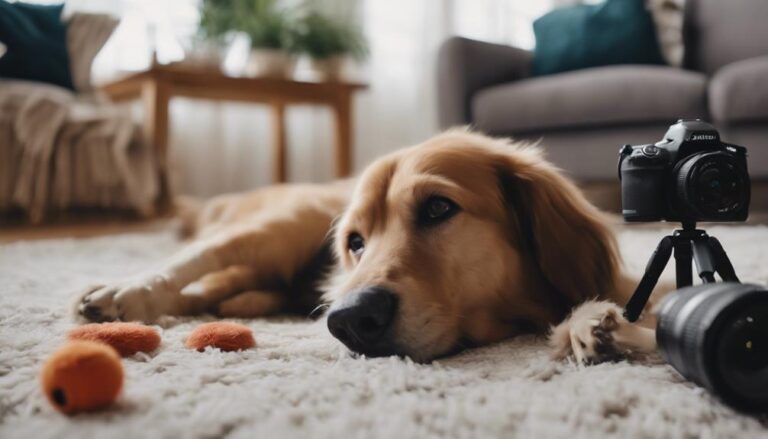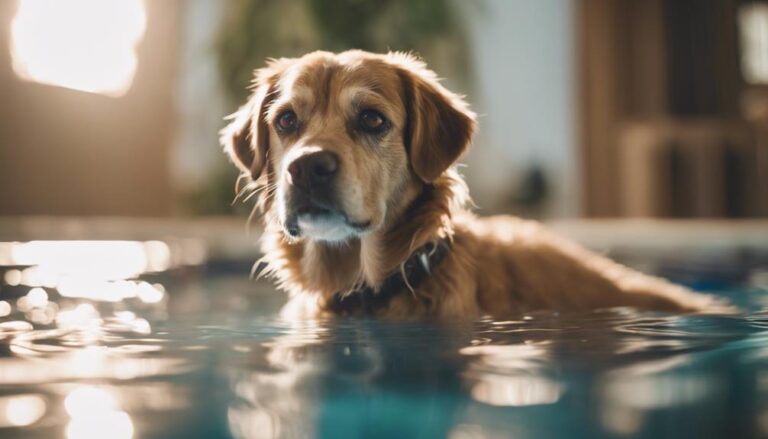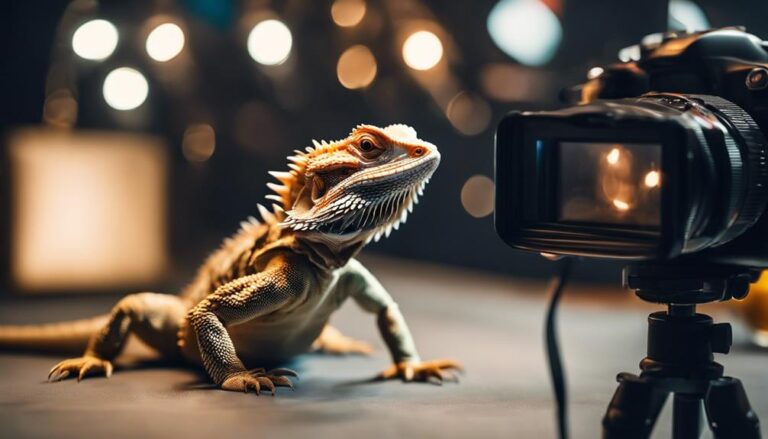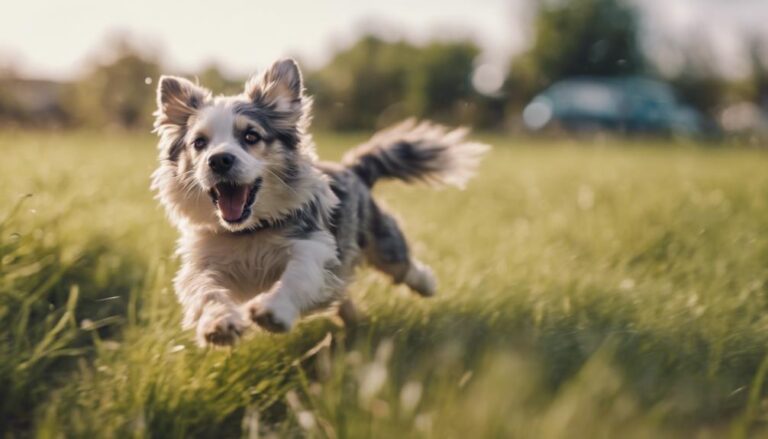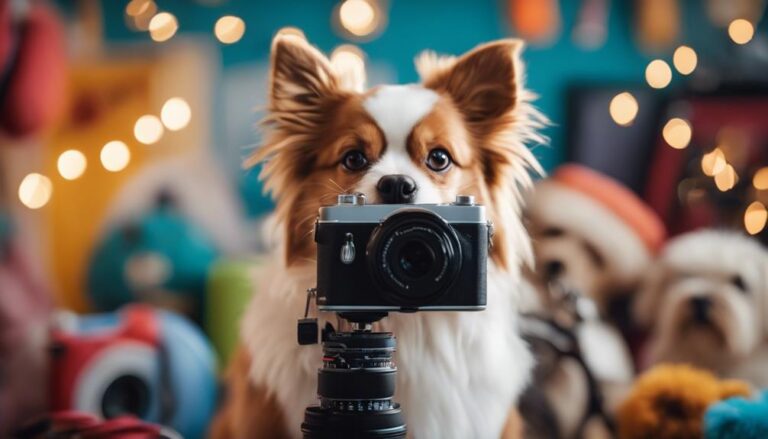Outdoor Pet Photography Safety Precautions
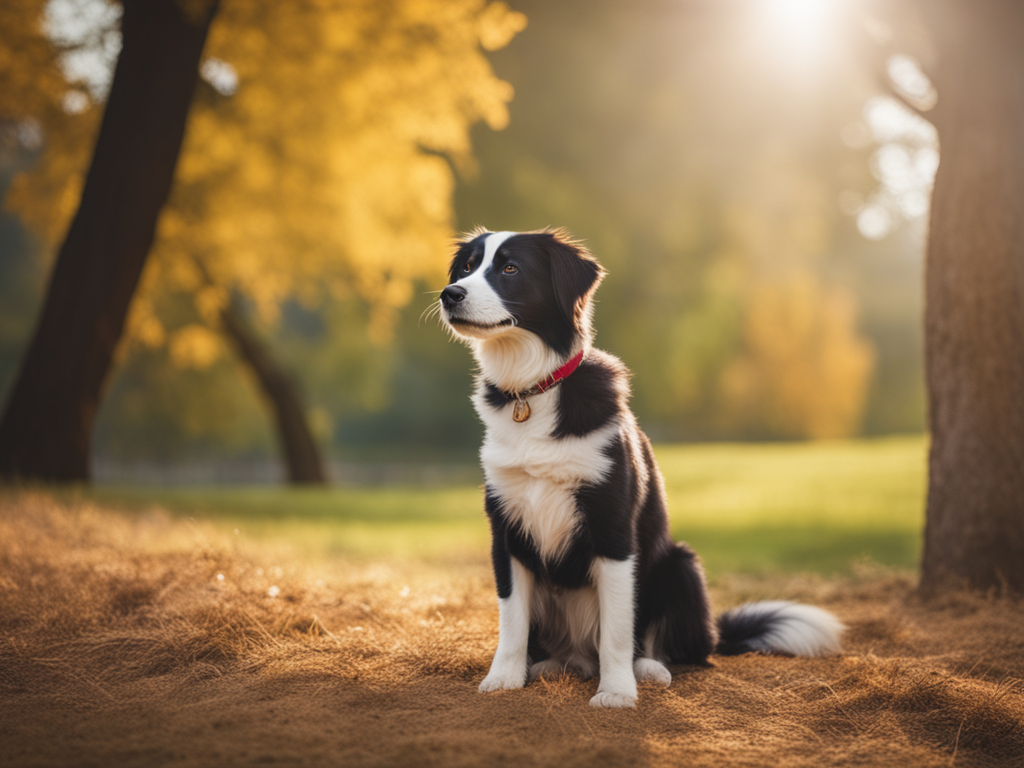
Outdoor Pet Photography Safety Precautions: Are you planning to capture some adorable photos of your furry friend in the great outdoors? Before you grab your camera, it’s important to take some safety precautions to ensure a smooth and enjoyable experience for both you and your pet. For instance, imagine you’re photographing your dog in a park, and suddenly they get spooked and run off.
By following a few simple guidelines, such as keeping them on a leash and collar, you can avoid potential accidents or losing your pet. In this guide, we will explore various safety measures to consider when photographing your pet outdoors, including identifying hazards, training tips, weather conditions, location choices, and even preparing a pet-friendly first aid kit. Let’s get started and capture those picture-perfect moments safely!
Leash and Collar Essentials
Make sure to always have your pet on a leash and with a properly fitted collar when engaging in outdoor pet photography. Leash training is crucial for the safety and control of your pet. Before heading out for a photoshoot, spend some time teaching your furry friend to walk calmly on a leash. Start by introducing them to the concept of wearing a collar and leash indoors, gradually moving to outdoor environments with more distractions. Use positive reinforcement techniques, such as treats and praise, to reward good behavior and help them associate the leash with positive experiences.
A properly fitted collar is essential to ensure your pet’s comfort and safety. When choosing a collar, make sure it is the right size for your pet’s neck. It should be snug enough to prevent slipping off, but not too tight to cause discomfort or restrict breathing. Check the fit regularly, especially as your pet grows or if they lose or gain weight. Opt for collars made of durable materials that can withstand outdoor activities and won’t easily break or fray.
In addition to a collar, consider using a harness for added security. Harnesses distribute pressure more evenly across your pet’s body, reducing the risk of neck injuries. They provide better control and minimize the chances of your pet slipping out of their collar, especially if they are particularly active or easily excitable.
Identifying Potential Hazards
Ensuring the safety of your pet during outdoor pet photography involves identifying potential hazards that could pose a risk to their well-being. The outdoor environment can be filled with various hazards that may not be present indoors. By being aware of these potential hazards, you can take the necessary precautions to keep your pet safe.
One potential hazard in the outdoor environment is toxic plants. Some plants, such as lilies, azaleas, and daffodils, can be poisonous to pets if ingested. It’s important to familiarize yourself with the plants in the area where you plan to photograph your pet and ensure they are safe for your furry friend.
Another potential hazard is wildlife. Depending on the location, you may encounter wild animals that could potentially harm your pet. Keep an eye out for snakes, coyotes, or other predators that may pose a threat. It’s a good idea to keep your pet on a leash and under close supervision to prevent any risky encounters.
Additionally, weather conditions can also be a potential hazard. Extreme heat or cold can be dangerous for your pet. Make sure to choose a time of day when the weather is mild and comfortable for your pet. If it’s too hot, consider finding a shaded area or bringing a portable water source to keep your pet hydrated.
Lastly, be mindful of any potential escape routes. Ensure that the area where you plan to photograph your pet is secure and that there are no holes or gaps in fences that could allow your pet to escape and potentially get lost or injured.
Ensuring Proper Pet Training
To ensure a successful outdoor pet photography session, it is crucial to have your pet properly trained. Basic obedience commands such as sit, stay, and come are essential for maintaining control and capturing the perfect shot. Leash and recall training will help prevent your pet from running off or getting into potentially dangerous situations. Additionally, socialization with other pets will help your furry friend feel more comfortable and relaxed in different outdoor environments.
Basic Obedience Commands
You can reinforce proper pet training by consistently practicing basic obedience commands both indoors and outdoors. Off-leash training is crucial for ensuring that your pet follows your commands even without a leash. Start with simple commands like “sit,” “stay,” and “come” and gradually progress to more complex ones. Use positive reinforcement such as treats, praise, and petting to reward your pet for obeying your commands. Consistency is key, so practice these commands daily and in different environments to ensure your pet’s obedience in any situation. Remember to be patient and understanding, as training takes time and effort. With proper training, your pet will become well-behaved and obedient, making outdoor pet photography sessions safer and more enjoyable for everyone involved.
Leash and Recall Training
To ensure proper pet training and safety during outdoor pet photography sessions, it is important to focus on leash and recall training. These skills are crucial for keeping your pet under control and preventing them from running off during a shoot. Here are three key tips for successful leash and recall training:
- Start early: Begin training your pet on a leash as soon as possible. This will help them become familiar with the concept and prevent any resistance later on.
- Consistency is key: Practice leash and recall training regularly to reinforce good behavior. Use positive reinforcement techniques such as treats and praise to encourage your pet to stay by your side and come when called.
- Gradual off-leash adventures: Once your pet has mastered leash and recall training, you can slowly introduce them to off-leash adventures. Start in a secure and controlled environment, and gradually increase the level of freedom as their training progresses.
Socialization With Other Pets
When socializing your pet with other animals, it is important to prioritize proper pet training to ensure a safe and positive experience. Whether you are taking your furry friend to dog parks or organizing playdates with other pets, training plays a crucial role in fostering good behavior and preventing any potential conflicts. Start by teaching your pet basic commands like sit, stay, and come, which will help you maintain control in social situations.
It is also important to work on leash manners and recall training to ensure your pet can be easily managed and brought back to you when needed. Additionally, expose your pet to different environments, noises, and smells to help them become more adaptable and comfortable around other animals. By investing time and effort into proper pet training, you can enjoy worry-free interactions between your pet and other animals.
Protecting Against Extreme Weather Conditions
To protect your pet against extreme weather conditions during outdoor photography sessions, it is important to dress them appropriately for the weather. Consider using protective clothing or accessories like coats, booties, or hats to keep them warm in cold weather and provide them with shade and breathable materials in hot weather. Additionally, ensure that there are shelter options available nearby, such as trees or covered areas, where your pet can seek refuge from extreme weather conditions.
Dressing for Weather
Make sure you dress appropriately for the weather to protect yourself and your pet during outdoor pet photography sessions. Here are three important tips to keep in mind when choosing your outfit:
- Wear stylish attire: Just because you’re going out for a photoshoot doesn’t mean you have to sacrifice style. Opt for fashionable yet functional clothing that suits the season. Consider layering your clothes to adapt to temperature changes throughout the day.
- Dress in seasonal clothing: It’s crucial to dress according to the weather conditions. In colder months, wear warm, insulated clothing, and don’t forget a hat, gloves, and scarf to protect yourself from the chill. In warmer months, choose light and breathable fabrics to stay cool and comfortable.
- Don’t forget about footwear: Your choice of footwear is important for your safety and mobility during outdoor pet photography sessions. Make sure to wear comfortable and sturdy shoes that provide good traction, especially if you’ll be walking on uneven terrain.
Shelter and Shade Options
Ensure your pet’s safety and comfort by providing them with suitable shelter and shade options to protect against extreme weather conditions during outdoor pet photography sessions. When photographing your pet outdoors, it is important to consider their well-being in various weather conditions. Shelter options such as a covered gazebo, a tent, or even a large umbrella can provide protection from rain or excessive sun exposure. These options can help keep your pet dry and cool, preventing any discomfort or health issues.
Additionally, shade options like trees or portable shade canopies can offer a cool and shaded area for your pet to rest during hot and sunny days. Remember, providing adequate shelter and shade is crucial to ensure your pet’s safety and prevent any potential harm from extreme weather conditions during your outdoor pet photography sessions.
Choosing Safe Locations for Outdoor Shoots
Select a safe location for your outdoor pet photography shoot.
When choosing a location for your outdoor pet photography shoot, it is important to prioritize safety. Here are three factors to consider:
- Accessibility: Look for a location that is easily accessible for both you and your pet. Consider the distance you will need to travel and whether the terrain is suitable for your pet’s abilities. You want to ensure that your pet can navigate the area comfortably without any risk of injury.
- Environmental hazards: Pay attention to any potential hazards in the location. Look out for poisonous plants, sharp objects, or any other dangers that could harm your pet. It is crucial to survey the area beforehand and remove any potential risks to keep your furry friend safe.
- Distractions and noise levels: To capture natural pet behaviors, it is important to choose a location that is relatively quiet and free from distractions. Avoid busy roads, crowded parks, or areas with loud noises that could startle or stress your pet. Opt for a peaceful setting where your pet can feel calm and relaxed.
Preparing a Pet-Friendly First Aid Kit
How can you effectively prepare a pet-friendly first aid kit for your outdoor pet photography shoot? It’s essential to have a well-stocked first aid kit to ensure the safety and well-being of your furry subjects. Here are some key items to include in your pet-friendly first aid kit.
First and foremost, make sure to have pet-friendly medication on hand. This includes items such as antihistamines for allergic reactions, hydrogen peroxide for inducing vomiting (only under veterinary guidance), and antibiotic ointment for minor wounds. It’s important to consult with your veterinarian before administering any medication to your pets.
Additionally, include emergency contact information in your first aid kit. This should include the contact details of your regular veterinarian, as well as the nearest emergency veterinary clinic. In case of an emergency, having this information readily available can save valuable time and potentially save your pet’s life.
Other essential items to include in your pet-friendly first aid kit are bandages, gauze pads, adhesive tape, and scissors. These items can be used to dress wounds and stop bleeding if necessary. It’s also a good idea to have a pair of tweezers on hand to remove any ticks or splinters.
Remember, prevention is better than cure. While having a well-stocked first aid kit is crucial, it’s equally important to prioritize the safety of your pets during the outdoor photography shoot. Keep a watchful eye on them, minimize potential hazards, and always have a leash or harness handy.
Outdoor Pet Photography Safety Precautions Frequently Asked Questions
What Are Some Common Leash and Collar Essentials That Pet Owners Should Have for Outdoor Pet Photography?
When taking photos of your pet outdoors, it’s important to have the right leash options and collar materials. Make sure you have a sturdy leash and a collar made of durable materials for added safety and control.
How Can Pet Owners Identify Potential Hazards in Outdoor Locations for Pet Photography?
When identifying hazards in outdoor locations for pet photography, you should be observant and cautious. Look out for potential dangers such as uneven terrain, toxic plants, and wildlife. Take precautionary measures to ensure your pet’s safety.
What Are Some Tips for Ensuring Proper Pet Training Before an Outdoor Pet Photography Session?
To ensure a successful outdoor pet photography session, focus on proper pet training techniques. Teach essential commands like “sit” and “stay” for better control and cooperation. This will make the session safer and more enjoyable for both you and your pet.
How Can Pet Owners Protect Their Pets Against Extreme Weather Conditions During Outdoor Pet Photography?
To protect your pet during outdoor pet photography in extreme weather conditions, make sure to dress them in protective clothing like jackets or booties and use safety equipment like sunscreen or goggles.
What Factors Should Pet Owners Consider When Choosing Safe Locations for Outdoor Pet Photography Shoots?
When choosing safe locations for outdoor pet photography, consider pet-friendly areas that provide ample natural lighting. This ensures your pet’s safety and allows for beautiful, well-lit photos.
Conclusion
In conclusion, when taking outdoor pet photographs, it is crucial to prioritize the safety and well-being of your furry friend. By using leashes and collars, identifying potential hazards, ensuring proper training, protecting against extreme weather conditions, choosing safe locations, and having a pet-friendly first aid kit, you can create a secure and enjoyable experience for both you and your pet. Remember to always prioritize their safety and comfort to capture the best moments while keeping them safe.



